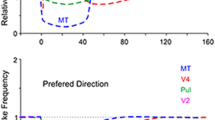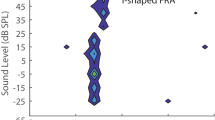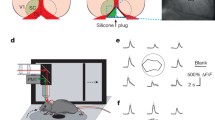Summary
Directional tuning for visual noise, bar and single spot stimuli was compared over a wide range of velocities in cells from areas 17 and 18 of the visual cortex in lightly-anaesthetized cats. In each area, S-cells were predominantly insensitive to motion of a field of visual noise. C-cells were more sensitive to noise motion than B-cells, but showed heterogeneity in noise sensitivity, which was associated with other response properties: strongly noise-sensitive C-cells had relatively high spontaneous activity and broad directional tuning, and were predominantly direction-selective and binocularly-driven. Frequently, directional tuning for noise was unimodal at low velocity, but became progressively more bimodal as velocity was increased: a trough of depressed response corresponding to the peak in tuning for the bar separated two progressively more widely disparate preferred directions. In area 18, cells with velocity tuned (VT) functions for bar motion developed bimodal tuning for noise well below the optimum velocity for bar or for noise motion, while velocity high-pass (VHP) cells became progressively more bimodally tuned for noise over a wide range of velocities, in parallel with a steep increase in response to bar and noise motion. A high proportion of VT and VHP cells was bimodally tuned for noise at all velocities, one VHP cell showing two discrete lobes of tuning for noise below the threshold velocity for bar motion. Among cells which remained unimodally tuned for noise, VT and VHP cells in area 18 had radically dissimilar preferred directions for noise and bar motion at all velocities. With the exception of VHP cells, velocity bandpass was higher for noise than for bar motion. These results, together with other novel observations on the modality of tuning for noise in preferred and opposite directions of motion, demonstrate that bimodality of tuning for noise cannot simply be an effect of upper cut-off velocity for bar motion (Movshon et al. 1980; Orban 1984). It is argued that the trough between the lobes of tuning arises through laterally-directed inhibitory convergence from superficial- and deep-layer, large basket cells. In 40% of noise-sensitive cells, tuning for bar motion was broader on the flank closest to the preferred direction for noise and for a moving spot, while some 25% of cells showed variations in tuning for bar motion with velocity, which were associated with velocity-dependent changes in tuning for noise. Thus, the broad, asymmetrical tuning of these cell types for bar motion presumably reflects to some extent stimulation of the directional mechanism by the moving bar. Quantitative comparisons showed that C-cells in each area had similar tuning for bar motion, which was substantially broader than that of S- or B-cells. S-cells had the narrowest tuning, though those in area 18 were more broadly tuned than those in area 17.
Similar content being viewed by others
References
Bishop PO, Coombs JS, Henry GH (1973) Receptive fields of simple cells in the cat striate cortex. J Physiol 231: 31–60
Bishop PO, Kato H, Orban GA (1980) Direction-selective cells in complex family in cat striate cortex. J Neurophysiol 43: 1266–1283
Bullier J, Kennedy H, Salinger W (1984) Branching and laminar origin of projections between visual cortical areas in the cat. J Comp Neurol 228: 329–341
Crook JM (1987) A neurophysiological investigation of the feline extrastriate visual cortex (area 18) using oriented and textured stimuli: a comparison with area 17. PhD thesis. University of Keele, UK
Crook JM (1990) Modulatory influences of a moving visual noise background on bar-evoked responses of cells in area 18 of the feline visual cortex. Exp Brain Res 80: 562–576
Crook JM, Eysel UT, Machemer HF (1989) Intracortical inhibition and orientation selectivity in areas 17 and 18 of cat visual cortex. 12th Annual Meeting of the European Neuroscience Association. Eur J Neurosci Suppl 2: P259
Dean AF, Tolhurst DJ (1983) On the distinctiveness of simple and complex cells in the visual cortex of the cat. J Physiol 344: 305–325
Ferster D, Lindström S (1983) An intracellular analysis of geniculocortical connectivity in area 17 of the cat. J Physiol 342: 181–215
Freund TF, Martin KAC, Whitteridge D (1985) Innervation of cat visual areas 17 and 18 by physiologically identified X- and Y-type thalamic afferents. I. Arborization patterns and quantitative distribution of postsynaptic elements. J Comp Neurol 242: 263–274
Gabbott PLA, Martin KAC, Whitteridge D (1987) Connections between pyramidal neurons in layer 5 of cat visual cortex (area 17). J Comp Neurol 259: 364–381
Gibson A, Baker J, Mower G, Glickstein M (1978) Corticopontine cells in area 18 of the cat. J Neurophysiol 41: 484–495
Gilbert CD (1977) Laminar differences in receptive field properties of cells in cat primary visual cortex. J Physiol 268: 391–421
Gilbert CD, Wiesel TN (1979) Morphology and intracortical projections of functionally characterised neurones in the cat visual cortex. Nature 280: 120–125
Gilbert CD, Wiesel TN (1983) Clustered intrinsic connections in cat visual cortex. J Neurosci 3: 1116–1133
Hammond P (1978) Directional tuning of complex cells in area 17 of the feline visual cortex. J Physiol 285: 479–491
Hammond P (1981a) Simultaneous determination of directional tuning of complex cells in cat striate cortex for bar and for texture motion. Exp Brain Res 41: 364–369
Hammond P (1981b) Non-stationarity of ocular dominance in cat striate cortex. Exp Brain Res 42: 189–195
Hammond P, Ahmed B (1985) Length summation of complex cells in cat striate cortex: a reappraisal of the “special/standard” classification. Neuroscience 15: 639–649
Hammond P, Ahmed B, Smith AT (1986) Relative motion sensitivity in cat striate cortex as a function of stimulus direction. Brain Res 386: 93–104
Hammond P, Andrews DP (1978) Orientation tuning of cells in areas 17 and 18 of the cat's visual cortex. Exp Brain Res 31: 341–351
Hammond P, Andrews DP, James CR (1975) Invariance of orientational and directional tuning in visual cortical cells of the adult cat. Brain Res 96: 56–59
Hammond P, MacKay DM (1977) Differential responsiveness of simple and complex cells in cat striate cortex to visual texture. Exp Brain Res 30: 275–296
Hammond P, MacKay DM (1981) Modulatory influences of moving textured backgrounds on responsiveness of simple cells in feline striate cortex. J Physiol 319: 431–442
Hammond P, MacKay DM (1983a) Effects of luminance gradient reversal on complex cells in cat striate cortex. Exp Brain Res 49: 453–456
Hammond P, MacKay DM (1983b) Influence of luminance gradient reversal on simple cells in feline striate cortex. J Physiol 337: 69–87
Hammond P, Reck J (1980) Influence of velocity on directional tuning of complex cells in cat striate cortex for texture motion. Neurosci Lett 19: 309–314
Hammond P, Smith AT (1983) Directional tuning interactions between moving oriented and textured stimuli in complex cells of feline striate cortex. J Physiol 342: 35–49
Hammond P, Smith AT (1984) Sensitivity of complex cells in cat striate cortex to relative motion. Brain Res 301: 287–298
Harvey AR (1980a) The afferent connections and laminar distribution of cells in area 18 of the cat. J Physiol 302: 483–505
Harvey AR (1980b) A physiological analysis of subcortical and commissural projections of areas 17 and 18 of the cat. J Physiol 302: 507–534
Henry GH, Dreher B, Bishop PO (1974) Orientation specificity of cells in cat striate cortex. J Neurophysiol 37: 1394–1409
Henry GH, Mustari MJ, Bullier J (1983) Different geniculate inputs to B and C cells of cat striate cortex. Exp Brain Res 52: 179–189
Hess R, Negishi K, Creutzfeldt OD (1975) The horizontal spread of intracortical inhibition in the visual cortex. Exp Brain Res 22: 415–419
Hoffmann K-P, Bauer R, Huber HP, Mayr M (1984) Single cell activity in area 18 of the cat's visual cortex during optokinetic nystagmus. Exp Brain Res 57: 118–127
Hubel DH, Wiesel TN (1962) Receptive fields, binocular interaction and functional architecture in the cat's visual cortex. J Physiol 160: 106–154
Hubel DH, Wiesel TN (1965) Receptive fields and functional architecture in two nonstriate visual areas (18 and 19) of the cat. J Neurophysiol 28: 229–289
Humphrey AL, Sur M, Uhlrich DJ, Sherman SM (1985) Termination patterns of X- and Y-cell axons in the visual cortex of the cat: projections to area 18, to the 17/18 border region, and to both areas 17 and 18. J Comp Neurol 233: 190–212
Ikeda H, Wright MJ (1974) Sensitivity of neurones in visual cortex (area 17) under different levels of anaesthesia. Exp Brain Res 20: 471–484
Kato H, Bishop PO, Orban GA (1978) Hypercomplex and the simple/complex cell classifications in cat striate cortex. J Neurophysiol 41: 1071–1095
Kisvárday ZF, Martin KAC, Freund TF, Magloczky Z, Whitteridge D, Somogyi P (1986) Synaptic targets of HRP-filled layer III pyramidal cells in the cat striate cortex. Exp Brain Res 64: 541–552
Kisvárday ZF, Martin KAC, Friedlander MJ, Somogyi P (1987) Evidence for interlaminar inhibitory circuits in the striate cortex of the cat. J Comp Neurol 260: 1–19
Kulikowski JJ, Bishop PO (1982) Silent periodic cells in the cat striate cortex. Vision Res 22: 191–200
LeVay S (1988) Patchy intrinsic projections in visual cortex, area 18, of the cat: morphological and immunocytochemical evidence for an excitatory function. J Comp Neurol 269: 265–274
MacKay DM, Yates SR (1975) Textured kinetic stimuli for use in visual neurophysiology: an inexpensive and versatile electronic display. J Physiol 252: 10–11P
Martin KAC, Somogyi P, Whitteridge D (1983) Physiological and morphological properties of identified basket cells in the cat's visual cortex. Exp Brain Res 50: 193–200
Martin KAC, Whitteridge D (1984) Form, function and intracortical projections of spiny neurones in the striate visual cortex of the cat. J Physiol 353: 463–504
Matsubara JA, Nance DM, Cynader M (1987) Laminar distribution of GABA-immunoreactive neurons and processes in area 18 of the cat. Brain Res Bull 18: 121–126
Morrone MC, Burr DC, Maffei L (1982) Functional implications of cross-orientation inhibition of cortical visual cells. I. Neurophysiological evidence. Proc R Soc Lond B216: 335–354
Movshon JA, Davis ET, Adelson EH (1980) Directional movement selectivity in cortical complex cells. Soc Neurosci Abstr 6: 670
Movshon JA, Thompson ID, Tolhurst DJ (1978) Spatial and temporal contrast sensitivity of neurones in areas 17 and 18 of the cat's visual cortex. J Physiol 283: 101–120
Orban GA (1984) Neuronal operations in the visual cortex: studies of brain function, Vol 11. Springer, Berlin
Orban GA, Callens M (1977a) Receptive field types of area 18 neurones in the cat. Exp Brain Res 30: 107–123
Orban GA, Callens M (1977b) Influence of movement parameters on area 18 neurones in the cat. Exp Brain Res 30: 125–140
Orban GA, Kennedy H (1981) The influence of eccentricity on receptive field types and orientation selectivity in areas 17 and 18 of the cat. Brain Res 208: 203–208
Orban GA, Kennedy H, Maes H (1980) Functional changes across the 17–18 border in the cat. Exp Brain Res 39: 177–186
Orban GA, Kennedy H, Maes H (1981) Response to movement of neurons in areas 17 and 18 of the cat: velocity sensitivity. J Neurophysiol 45: 1043–1058
Palmer LA, Rosenquist AC (1974) Visual receptive fields of single striate cortical units projecting to the superior colliculus in the cat. Brain Res 67: 27–42
Pollen DA, Andrews BW, Feldon SE (1978) Spatial frequency selectivity of periodic complex cells in the visual cortex of the cat. Vision Res 18: 665–682
Redies C, Crook JM, Creutzfeldt OD (1986) Neuronal responses to borders with and without luminance gradients in cat visual cortex and dorsal lateral geniculate nucleus. Exp Brain Res 61: 469–481
Schoppmann A (1981) Projections from areas 17 and 18 of the visual cortex to the nucleus of the optic tract. Brain Res 223: 1–17
Sillito AM (1975) The contribution of inhibitory mechanisms to the receptive field properties of neurones in the striate cortex of the cat. J Physiol 250: 305–329
Sillito AM (1979) Inhibitory mechanisms influencing complex cell orientation selectivity and their modification at high resting discharge levels. J Physiol 289: 33–53
Skottun BC, Grosof DH, DeValois RL (1988) Responses of simple and complex cells to random dot patterns: a quantitative comparison. J Neurophysiol 59: 1719–1735
Somogyi P, Kisvárday ZF, Martin KAC, Whitteridge D (1983) Synaptic connections of morphologically identified and physiologically characterized large basket cells in the striate cortex of the cat. Neuroscience 10: 261–294
Stone J, Dreher B (1973) Projection of X- and Y-cells of the cat's lateral geniculate nucleus to areas 17 and 18 of visual cortex. J Neurophysiol 36: 551–567
Toyama K, Kimura M, Tanaka K (1981) Organization of cat visual cortex as investigated by cross-correlation technique. J Neurophysiol 46: 202–214
Tretter F, Cynader M, Singer W (1975) Cat parastriate cortex: a primary or secondary visual area? J Neurophysiol 38: 1099–1113
Vidyasagar TR, Heide W (1986) The role of GABAergic inhibition in the response properties of neurones in cat visual area 18 Neuroscience 17: 49–55
Wagner H-J, Hoffmann K-P, Zwerger H (1981) Layer-specific labelling of cat visual cortex after stimulation with visual noise: a [3H] 2-deoxy-d-glucose study. Brain Res 224: 31–43
Author information
Authors and Affiliations
Rights and permissions
About this article
Cite this article
Crook, J.M. Directional tuning of cells in area 18 of the feline visual cortex for visual noise, bar and spot stimuli: a comparison with area 17. Exp Brain Res 80, 545–561 (1990). https://doi.org/10.1007/BF00227995
Received:
Accepted:
Issue Date:
DOI: https://doi.org/10.1007/BF00227995




